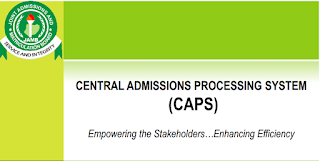JAMB Central Admission Processing System (CAPS) Overview
JAMB Central Admission Processing System (CAPS) Overview.

The Joint Admission Matriculation Board [JAMB] on 20th August, 2017 held a meeting with other Stakeholders concerning the admission process.
After the meeting it was decided that the Joint Admission Matriculation Board will adopt a special admission process called the “Central Admission Processing System [CAPS]”. It was also at the meeting that the admission cutoff points were also announced.
For those who have been hearing of the JAMB Central Admission Processing System [CAPS] but have no idea or little knowledge about it, we are glad to bring to you a brief overview and all you need to know about the newly introduced admission policy.
AGENDA
- Why CAPS? Purpose & Objectives
- Admissions Process Workflow
- Actors, Roles & Responsibilities
- Challenges & Mitigants
- Critical Success Factors
- Next Steps
- Conclusion
A. Why CAPS? Purpose & Objectives
- Addresses Current Challenges
- Delivers Benefits of Automation
- Offers Significant Innovations
a. Current Challenges
- Undermines Autonomy of Institutions
- Manual Process Prone to Errors
- Laborious and Inefficient
- Multiple Admissions for Candidates
- Constrains Admissions Opportunities
- Lack of Timely Information for Decision Making
- Insufficiency of Easily Retrievable Data for Research & Planning
b. The CAPS Advantage
- Restores Autonomy of Institutions
- Protects Academic Calendar
- Refocuses JAMB’s founding Ideals as Clearing House
- Expands Admission Opportunities for Candidates
- Provides Credible and Easily Retrievable Data for
- Researching & Planning on Education Sector
- Access to Data for Research Purposes
- Enhances Inclusiveness, Equity, Transparency & Accountability in the Admission Process
- Efficient Use of Time and Resources
- Automation Minimises Human Errors
- Eliminates Multiple Admissions
- Significantly reduces Attrition Rate
- Enforces Respect for Internal Rules & Discourages Arbitrariness
- Provides for Instant Admission
- Makes Candidates the Central Focus
c. Some Innovations To The Bargain
- O/L Results Upload, Requirement for Admission Consideration
- Interface with NECO & WAEC for automated Results Verification
- Candidates’ Confirmation of Admission Offer
- “Market Place” to Source Candidates
- Automatic Enforcement of Admission Timelines
B. Admissions Process Workflow
1. Policy Meeting
2. User Profiles Creation on the System
3. Admission Parameters Setting on the System
4. Candidates Download by Institutions
5. Internal Processing by Institutions / Including Post UTME Screening
6. Upload of Post UTME Screening Results
7. Further Processing by Institutions
8. Systems Creating Suggested Admission List Based on the Institution’s Admission Criteria
9. Admission Officer Preparing Proposed List for Head of Institution’s Review and Approval
10. Institution Forwards Recommended List to JAMB Desk Officer
11. Desk Officer Processes Recommended List and Generates List of Provisional Admissions
12. JAMB Contacts Candidates to Accept or Decline Admission
13. If Candidate Accepts, Admission is concluded for Candidate
14. If Candidate Declines, s(he) is returned to Market Place for Possible Consideration by Other Institutions
C. Actors, Roles & Responsibilities
- JAMB Conducts UTME and Makes Results Available to Institutions
- Institutions Set Admission Criteria on the System
- Admission Officer Downloads Candidates, Coordinates Internal Admission Process and Uploads Aggregate Results
- Head of Institution Approves and Forwards Recommended List to JAMB
- JAMB Approves List of Provisional Admissions and Contacts Candidates
- Candidate Accepts or Declines Admission
D. Challenges, Risks & Mitigants
1. Security
- Secure Technology
- Strong User Authentication
- Confidential & Individual Log-in Profile
- Comprehensive Audit Trail of ALL activities
2. Fit-for-Purpose
- Inputs from & Collaboration with Stakeholders (Admission Officers, Desk Officers & IT CAPS Team)
- Agile Development Approach
- Dual Mode (2017/ 2018) Session
3. Knowledge / Capacity Gaps
- Capacity Building
- Comprehensive User Guide (Printed and Online)
- Intuitive User Interface / Ease of Use
- Parameters Setting to guide operations
- Help Desk / Ticketing System for Support
- Information & Awareness for ALL Stakeholders
4. Technology Challenge
- Simple but yet Cost Effective & Secure Technology
- Offline Processing Capability by Institutions
- Ease of Installing Updates & Upgrades
E. Critical Success Factors
- Ownership of The System by Stakeholders
- Capacity Building in Institutions
- Adherence to Admission Workflow Timelines
- Sustainability (JAMB’s own Product)
- Feedbacks and Continuous Improvement
F. Next Steps
- Practical Training
- System Settings: Carrying Capacity, Cut‐Off Marks, etc
- Download of Candidates
- Capacity Building in Institutions
- Dual Processing
- Feedbacks & Suggestions
- Continuous Improvement
G. Conclusion